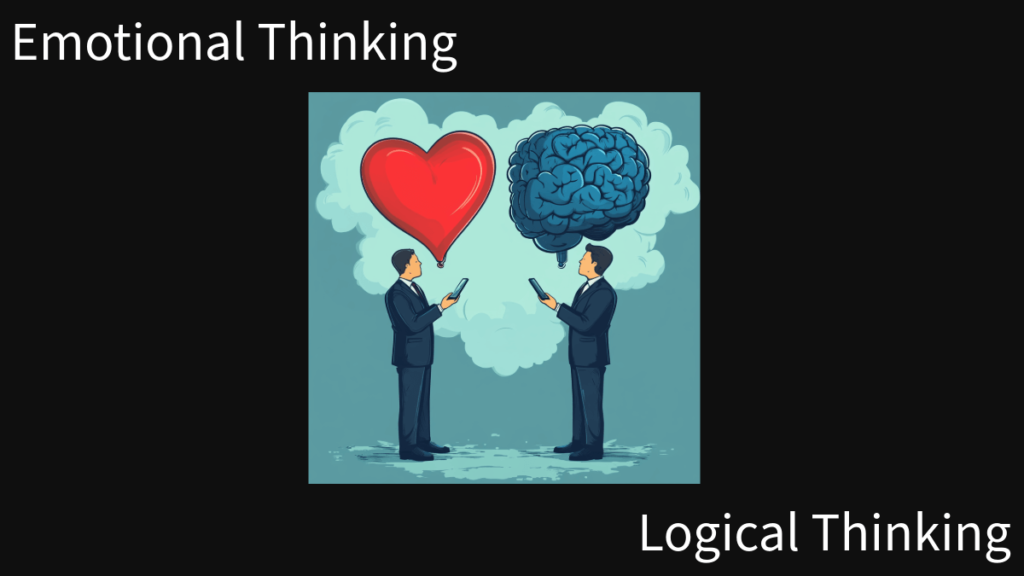Logical Thinking Over Emotional Thinking: Balancing Rationality and Intuition for Predictable Outcomes
In the realm of cybersecurity, both logical and emotional thinking have roles to play. However, when the objective is to create predictable, effective outcomes and safeguard critical systems, a primary emphasis on logical thinking is paramount and thus why logical thinking over emotional thinking becomes a primary objective. This approach ensures that decisions are based on rigorous analysis and objective data, even while acknowledging that emotional insight—through imagination and intuition—can occasionally enhance problem-solving.

The Role of Logical Thinking:
Data-Driven Decision Making:
Logical thinking relies on facts, evidence, and systematic analysis. In cybersecurity, this translates into a disciplined approach where every decision is supported by quantifiable data and proven methodologies. By prioritizing logic, organizations can reduce the risk of bias and impulsivity that might arise from emotional reactions, leading to more consistent and reliable security outcomes once logical thinking over emotional thinking becomes second nature.
Predictability and Consistency:
When decisions are anchored in logical frameworks, outcomes become more predictable. This is crucial in environments where consistency can mean the difference between a secure system and a vulnerable one. Logical thinking enables security professionals to design strategies that are not only robust but also repeatable, ensuring that each component of the security infrastructure contributes to a stable overall defense.
The Complementary Role of Emotional Thinking:
Fostering Creativity and Innovation:
Emotional thinking, characterized by intuition and imaginative problem-solving, can spark innovative ideas and approaches that might not emerge from purely analytical processes. This creative input is valuable, especially when facing unprecedented challenges or when existing frameworks fall short. However, these insights must be rigorously evaluated through a logical lens before being integrated into security strategies.
Balancing Act:
The key is to balance emotional insights with logical analysis. While gut feelings and creative intuition can provide fresh perspectives, they need to be tempered by systematic evaluation to ensure that innovative ideas are both viable and secure. This balanced approach prevents decisions from being swayed by transient emotions or subjective experiences, instead anchoring them in the reality of risk assessments and strategic planning.
Cultivating a Logical-Centric Approach: While Understanding both Logic and Emotion Aspects
Structured Methodologies:
Cybersecurity strategies should be built on structured, repeatable processes that prioritize data and logic. This includes thorough risk assessments, scenario-based testing, and continuous monitoring that are all driven by clear, measurable criteria.
Evidence-Based Practices:
Adopting an evidence-based approach ensures that every security measure is justified by concrete data and historical trends. Logical thinking demands that decisions are made after careful analysis of potential outcomes, reducing the likelihood of errors that stem from overreliance on untested intuition.
Training and Continuous Improvement:
Continuous education is vital for cultivating a logical mindset. Training programs should not only cover technical skills but also emphasize analytical reasoning, critical evaluation of threats, and structured problem-solving techniques. This equips security professionals to weigh emotional insights appropriately against the rigors of logic.
Real-World Impact: Feeling and Thinking Crucial Distinctions
Minimizing Risk:
Logical thinking minimizes the risk of overreaction or underreaction by ensuring that responses to threats are proportionate and based on objective assessments. This minimizes the chance of cascading failures that might occur if decisions are driven by panic or overly optimistic assumptions.
Enhancing Predictability:
By grounding strategies in logic, organizations can better forecast potential vulnerabilities and develop systematic responses. This predictability not only strengthens defenses but also builds trust among stakeholders who rely on consistent security practices.
Conclusion: Emotional Thinking vs Thinking Logically
In summary, while emotional thinking can contribute valuable creative insights, the foundation of a robust cybersecurity strategy must be built on logical thinking. By prioritizing data-driven decision-making and structured methodologies, organizations can achieve the balance necessary to innovate responsibly while maintaining predictability and control. In an environment where the stakes are high and the threats constantly evolve, a logical focus on outcomes is essential for building resilient, forward-thinking security frameworks. Therefore the focus of leaders should be to instill logical thinking over emotional thinking.





